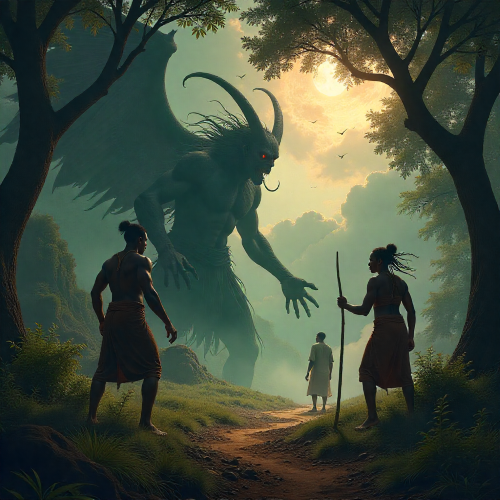
Warumbe and the Origin of Mortality
Listen
At a glance
| Description | |
|---|---|
| Mythology | Baganda Mythology |
| Cursed Individual(s) | All descendants of Kintu |
| Cursed By | Warumbe |
| Primary Consequence | Mortality and death |
| Symbolism | Disobedience, inevitability of fate, cosmic justice |
Curse of Kintu
Introduction
The Curse of Death is one of the most powerful and enduring legends in Baganda mythology, centering on Warumbe—also known as Walumbe—the spirit who brought death and disease into the world. This myth, deeply rooted in Uganda’s cultural and spiritual heritage, explains the inevitable presence of mortality and its origins in divine disobedience. Far from being a simple story of creation and punishment, the Curse of Death represents the Baganda understanding of balance between life and death, the consequences of human choices, and the permanence of spiritual law in the mortal realm.
Mythological Background
In Baganda cosmology, the world was shaped by Ggulu, the supreme god who resided in the heavens with his children, including Nambi and Warumbe. Kintu, the first human, lived alone on Earth until he journeyed to Ggulu’s celestial realm to seek companionship and favor. After enduring Ggulu’s trials, Kintu was permitted to marry Nambi, who descended to Earth with him to begin human life.
However, Ggulu warned them never to return to the heavens once they left, fearing that Nambi’s brother, Warumbe—the embodiment of death and sickness—would follow them. This divine warning symbolized the fragile boundary between immortality and mortality. Yet, when Nambi realized she had forgotten to bring millet for her hen, she went back, unknowingly allowing Warumbe to follow. This act of forgetfulness and disobedience marked the beginning of the curse that would forever alter human existence.
Origin of the Curse
The Curse of Death began when Warumbe descended to Earth and demanded that Kintu give him one of his children as a servant—a symbolic gesture to share in humanity’s joy of life. Kintu refused, viewing Warumbe’s request as malicious and unnatural. Angered by this rejection, Warumbe declared that he would take the children himself. True to his word, he began killing one child every day, bringing death into the world.
When Kintu appealed to Ggulu for help, the sky god sent another of his sons, Kayikuuzi (“the Digger”), to capture Warumbe and return him to heaven. But Warumbe eluded him by digging deep into the ground, creating the famous Walumbe Tanda pits in the Mityana district. Despite Kayikuuzi’s efforts, humanity failed to remain silent long enough to trap Warumbe, and he escaped once more into the earth. From then on, death became an unending part of human life—a punishment, a lesson, and an inescapable destiny.
Nature of the Curse
The curse was more than a single act of divine vengeance—it was the establishment of a universal law. Warumbe’s curse was eternal, ensuring that every human born on Earth would one day die. The Baganda people came to understand death not as a random event, but as an inherent aspect of existence controlled by spiritual forces beyond human understanding.
In their worldview, the curse also represents the severing of the bond between humans and the divine. By defying Ggulu’s command, Kintu and Nambi opened the gateway for Warumbe to enter their world, thus transforming Earth into a realm governed by both life and decay. Death was no longer a punishment from the gods but a permanent law written into the fabric of human destiny.
Victims and Key Figures
The myth of the Curse of Death features several central figures, each symbolizing a distinct force in the Baganda spiritual system.
Warumbe (Walumbe) is the embodiment of death, whose name literally means “disease” or “death” in Luganda. He represents the inevitability of human mortality and the destructive side of divine power.
Kintu, the first man, embodies humanity’s innocence and moral struggle. Though blameless in intent, his refusal to share life with Warumbe set the cycle of death into motion. Nambi, daughter of Ggulu and wife of Kintu, symbolizes compassion and human imperfection. Her forgetfulness and emotional decision to return to heaven became the cause of humanity’s suffering.
Ggulu (Mugulu) represents divine authority and cosmic order. His warning underscores the need to respect spiritual boundaries and the limits of human autonomy. Kayikuuzi, the divine hero sent to capture Warumbe, signifies divine intervention and the continuous human effort to resist death. His failure illustrates the futility of escaping fate.
Mpoobe, the hunter who encounters Warumbe underground in later tales, symbolizes human curiosity and the tragic consequences of defying spiritual promises. His eventual death reaffirms the unbreakable nature of Warumbe’s curse.
Consequences and Resolution
The most profound consequence of the Curse of Death was the introduction of mortality to humanity. From that point on, life became a fleeting experience defined by inevitable decay. Though Kintu continued to populate the Earth to outnumber the deaths caused by Warumbe, the balance of life and death was established permanently.
Kayikuuzi’s inability to capture Warumbe ensured that death remained hidden but ever-present, residing beneath the Earth’s surface. This is why the Baganda traditionally bury their dead underground—returning them to the domain of Warumbe. The myth concludes with Ggulu allowing Warumbe to remain on Earth, acknowledging that death, once unleashed, could never be undone.
This resolution reflects the Baganda philosophical acceptance of mortality as a natural, divine order rather than a punishment. Death, in this context, is not the end but the fulfillment of a cosmic balance between the living and the spiritual realms.
Symbolism and Moral Lessons
The Curse of Death myth is layered with symbolic meaning. Warumbe represents both destruction and continuity—while he brings death, he also ensures the renewal of generations. Kintu’s defiance symbolizes humanity’s struggle against mortality, while Nambi’s mistake illustrates how even small acts of disobedience can alter the cosmic order.
The myth teaches respect for divine law, emphasizing that human actions have lasting spiritual consequences. It also encourages acceptance of death as part of the natural cycle. For the Baganda, life is meaningful precisely because it is temporary, and death serves as a reminder of the divine origin from which all beings emerge and to which they return.
Furthermore, the myth promotes moral discipline and spiritual mindfulness, reinforcing the belief that harmony with the divine ensures peace, while defiance leads to chaos and suffering.
Cultural Impact and Legacy
The story of Warumbe continues to shape Baganda beliefs, rituals, and cultural expressions. The Walumbe Tanda Pits remain a sacred site in Uganda, where locals pay homage to the spirit of death and the ancestral forces that govern existence. These craters are viewed as portals to the underworld, linking the mythic past to the living present.
The legend is retold in songs, oral narratives, and modern performances, including Kaz Kasozi’s 2007 musical Kyazze Tekizzikayo, which reinterprets the myth for a contemporary audience. Even today, the themes of death, curses, and spirit possession are central to Ugandan spirituality. Many people continue to see illness and death as signs of supernatural imbalance, reflecting the deep cultural roots of the Warumbe narrative.
In a broader sense, the Curse of Death functions as both a mythic explanation and a philosophical reflection on human mortality. It connects generations through shared understanding, reminding the Baganda people that while life may be fragile, it is sacred precisely because it is finite.
Source
Kagwa, A. (1934). The Customs of the Baganda. London: Macmillan.
Roscoe, J. (1911). The Baganda: An Account of Their Native Customs and Beliefs. London: Macmillan.
Wikipedia contributors. (2025). Warumbe. In Wikipedia. https://en.wikipedia.org/wiki/Warumbe
Lukwata, J. (2001). African Traditional Religion and Christian Counselling. Nairobi: Pauline Publications.
Scribd. (2025). The Concept of Death Among The Baganda. https://www.scribd.com/document/….
OmenkaMag. (2024). Unveiling the Mysteries of African Curses – African Life. https://omenkamag.com/african-curses
Mbiti, J. S. (2002). African Religions and Philosophy (2nd ed.). Heinemann.
Kiyimba, A. (2005). Oral Literature and the Transmission of Cultural Values in Buganda. Makerere Journal of Higher Education, 2(1), 45–58.
Nannyonga-Tamusuza, S. (2005). Baakisimba: Gender in the Music and Dance of the Baganda People of Uganda. Routledge.
Wrigley, C. C. (1959). Kingship and State: The Buganda Dynasty. Cambridge University Press.
Frequently Asked Questions
Who is Warumbe in Baganda mythology?
Warumbe, also known as Walumbe, is the personification of death and disease in Baganda mythology. His name literally means “death” in the Luganda language. According to legend, he followed his sister Nambi and her husband Kintu to Earth against divine warnings, bringing mortality and suffering into the human world.
What caused the Curse of Death to begin?
The Curse of Death originated when Nambi disobeyed her father Ggulu’s warning and returned to heaven for forgotten millet after leaving with Kintu. This act allowed Warumbe to accompany them to Earth. When Kintu refused to give one of his children to Warumbe as requested, Warumbe cursed humanity by killing one child every day, thus introducing death to humankind.
What do the Walumbe Tanda pits represent?
The Walumbe Tanda pits, located near Mityana in Uganda, are said to be the hiding places of Warumbe after he fled underground to escape capture by Kayikuuzi, Ggulu’s son. These craters are now sacred sites that symbolize the link between Earth and the spiritual realm, representing the eternal presence of death beneath the human world.
What is the moral lesson of the Curse of Death myth?
The myth teaches the importance of obeying divine guidance and respecting spiritual laws. It emphasizes that human actions, even small mistakes, can have irreversible consequences. The story also helps the Baganda people accept death as a natural, divinely ordained part of life rather than a punishment.
How does the Curse of Death influence modern Baganda culture?
The myth of Warumbe continues to shape Baganda cultural identity through funeral customs, spiritual beliefs, and storytelling traditions. The idea that death is a spiritual force rather than a mere biological event influences how communities honor ancestors and conduct rituals. The Walumbe legend remains a cornerstone of Ugandan mythology, symbolizing humanity’s ongoing relationship with life, death, and the divine.






